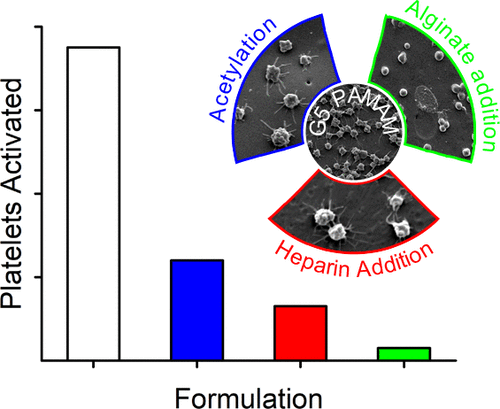当前位置:
X-MOL 学术
›
Biomacromolecules
›
论文详情
Our official English website, www.x-mol.net, welcomes your
feedback! (Note: you will need to create a separate account there.)
Nonthrombogenic Hydrogel Coatings with Carbene-Cross-Linking Bioadhesives
Biomacromolecules ( IF 5.5 ) Pub Date : 2018-02-09 00:00:00 , DOI: 10.1021/acs.biomac.8b00074 Himansu Sekhar Nanda 1, 2 , Ankur Harish Shah 1 , Gautama Wicaksono 1 , Oleksandr Pokholenko 1 , Feng Gao 1 , Ivan Djordjevic 3 , Terry W. J. Steele 1
Biomacromolecules ( IF 5.5 ) Pub Date : 2018-02-09 00:00:00 , DOI: 10.1021/acs.biomac.8b00074 Himansu Sekhar Nanda 1, 2 , Ankur Harish Shah 1 , Gautama Wicaksono 1 , Oleksandr Pokholenko 1 , Feng Gao 1 , Ivan Djordjevic 3 , Terry W. J. Steele 1
Affiliation

|
Bioadhesives are a current unmet clinical need for mending of blood contacting soft tissues without inducing thrombosis. Recent development of carbene precursor bioadhesives with the advantages of on-demand curing, tuneable modulus, and wet adhesion have been synthesized by grafting diazirine onto poly (amidoamine) (PAMAM-G5) dendrimers. Herein, the structure activity relationships of platelet adhesion and activation is evaluated for the first time on the cured PAMAM-g-diazirine bioadhesives. Three strategies were employed to prevent healthy human donor platelets from adhering and activating on light-cured bioadhesive surfaces: (1) Attenuation of cationic surface charge, (2) antifouling composites by incorporating heparin and alginate in uncured formulation, and (3) heparin wash of cured bioadhesive surface. Topographical imaging of cured and ethanol dehydrated bioadhesive surfaces was used to quantify the adhered and activated platelets with scanning electron microscopy, whose resolution allowed identification of round senescent, short dendritic, and long dendritic platelets. Cured surfaces of PAMAM-g-diazirine (15%) had 10300 ± 500 adhered platelets mm–2 with 99.7% activation into short/long dendritic cells. Reduction of primary amines by higher degree of diazirine grafting or capping of free amines by acetylation reduces platelet adherence (2400 ± 200 vs 3000 ± 300, respectively). Physical incorporation of heparin and alginate in the formulations reduced the activated platelet; 1300 ± 300 and 300 ± 50, activated platelets mm–2, in comparison with additive free adhesive formulation. Similarly, heparin rinse of the surface of additive free bioadhesive reduced the activated platelet to platelets of heparin composites at 600 ± 100 platelets mm–2. PAMAM-g-diazirine (15%) bioadhesive retained the photocured mechanical properties and lap shear adhesion despite the addition of heparin and alginate additives.
中文翻译:

碳烯交联生物胶粘剂的非血栓形成性水凝胶涂层
生物粘合剂是目前尚未满足的临床需要,用于在不引起血栓形成的情况下修补接触软组织的血液。卡宾前体生物粘合剂的最新开发具有按需固化,可调节模量和湿粘合性的优点,是通过将重氮嗪接枝到聚(酰胺基胺)(PAMAM-G5)树枝状聚合物上而合成的。在本文中,首次评估了固化的PAMAM-g-二氮嗪生物粘合剂对血小板粘附和活化的结构活性关系。采取了三种策略来防止健康的人类供体血小板在光固化的生物粘附性表面上粘附和活化:(1)减轻阳离子表面电荷,(2)通过在未固化的制剂中加入肝素和藻酸盐来形成防污复合材料,以及(3)肝素洗涤固化的生物粘附表面。固化和乙醇脱水的生物粘附表面的形貌成像用于通过扫描电子显微镜对粘附和活化的血小板进行定量,其分辨率允许鉴定圆形衰老,短树突状和长树突状血小板。PAMAM-g-diazirine(15%)的固化表面具有10300±500粘附的血小板mm–2具有99.7%的激活能力,可进入短/长树突状细胞。通过较高程度的二嗪胺接枝还原伯胺或通过乙酰化封端游离胺会降低血小板粘附(分别为2400±200和3000±300)。在制剂中物理掺入肝素和藻酸盐可减少活化的血小板;1300±300和300±50,活化血小板mm –2,与无添加剂胶粘剂配方相比。同样,在无添加剂的生物粘附剂表面进行肝素冲洗,在600±100血小板mm –2时,活化的血小板减少为肝素复合材料的血小板。尽管添加了肝素和藻酸盐添加剂,但PAMAM-g-diazirine(15%)生物粘合剂仍保留了光固化的机械性能和搭接剪切粘合力。
更新日期:2018-02-09
中文翻译:

碳烯交联生物胶粘剂的非血栓形成性水凝胶涂层
生物粘合剂是目前尚未满足的临床需要,用于在不引起血栓形成的情况下修补接触软组织的血液。卡宾前体生物粘合剂的最新开发具有按需固化,可调节模量和湿粘合性的优点,是通过将重氮嗪接枝到聚(酰胺基胺)(PAMAM-G5)树枝状聚合物上而合成的。在本文中,首次评估了固化的PAMAM-g-二氮嗪生物粘合剂对血小板粘附和活化的结构活性关系。采取了三种策略来防止健康的人类供体血小板在光固化的生物粘附性表面上粘附和活化:(1)减轻阳离子表面电荷,(2)通过在未固化的制剂中加入肝素和藻酸盐来形成防污复合材料,以及(3)肝素洗涤固化的生物粘附表面。固化和乙醇脱水的生物粘附表面的形貌成像用于通过扫描电子显微镜对粘附和活化的血小板进行定量,其分辨率允许鉴定圆形衰老,短树突状和长树突状血小板。PAMAM-g-diazirine(15%)的固化表面具有10300±500粘附的血小板mm–2具有99.7%的激活能力,可进入短/长树突状细胞。通过较高程度的二嗪胺接枝还原伯胺或通过乙酰化封端游离胺会降低血小板粘附(分别为2400±200和3000±300)。在制剂中物理掺入肝素和藻酸盐可减少活化的血小板;1300±300和300±50,活化血小板mm –2,与无添加剂胶粘剂配方相比。同样,在无添加剂的生物粘附剂表面进行肝素冲洗,在600±100血小板mm –2时,活化的血小板减少为肝素复合材料的血小板。尽管添加了肝素和藻酸盐添加剂,但PAMAM-g-diazirine(15%)生物粘合剂仍保留了光固化的机械性能和搭接剪切粘合力。











































 京公网安备 11010802027423号
京公网安备 11010802027423号